Quoc Le
HaloQuest: A Visual Hallucination Dataset for Advancing Multimodal Reasoning
Jul 22, 2024Abstract:Hallucination has been a major problem for large language models and remains a critical challenge when it comes to multimodality in which vision-language models (VLMs) have to deal with not just textual but also visual inputs. Despite rapid progress in VLMs, resources for evaluating and addressing multimodal hallucination are limited and mostly focused on evaluation. This work introduces HaloQuest, a novel visual question answering dataset that captures various aspects of multimodal hallucination such as false premises, insufficient contexts, and visual challenges. A novel idea from HaloQuest is to leverage synthetic images, apart from real ones, to enable dataset creation at scale. With over 7.7K examples spanning across a wide variety of categories, HaloQuest was designed to be both a challenging benchmark for VLMs and a fine-tuning dataset for advancing multimodal reasoning. Our experiments reveal that current models struggle with HaloQuest, with all open-source VLMs achieving below 36% accuracy. On the other hand, fine-tuning on HaloQuest significantly reduces hallucination rates while preserving performance on standard reasoning tasks. Our results discover that benchmarking with generated images is highly correlated (r=0.97) with real images. Last but not least, we propose a novel Auto-Eval mechanism that is highly correlated with human raters (r=0.99) for evaluating VLMs. In sum, this work makes concrete strides towards understanding, evaluating, and mitigating hallucination in VLMs, serving as an important step towards more reliable multimodal AI systems in the future.
Gemini: A Family of Highly Capable Multimodal Models
Dec 19, 2023Abstract:This report introduces a new family of multimodal models, Gemini, that exhibit remarkable capabilities across image, audio, video, and text understanding. The Gemini family consists of Ultra, Pro, and Nano sizes, suitable for applications ranging from complex reasoning tasks to on-device memory-constrained use-cases. Evaluation on a broad range of benchmarks shows that our most-capable Gemini Ultra model advances the state of the art in 30 of 32 of these benchmarks - notably being the first model to achieve human-expert performance on the well-studied exam benchmark MMLU, and improving the state of the art in every one of the 20 multimodal benchmarks we examined. We believe that the new capabilities of Gemini models in cross-modal reasoning and language understanding will enable a wide variety of use cases and we discuss our approach toward deploying them responsibly to users.
Beyond ChatBots: ExploreLLM for Structured Thoughts and Personalized Model Responses
Dec 01, 2023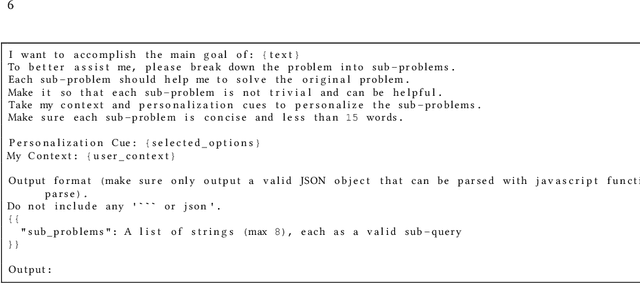
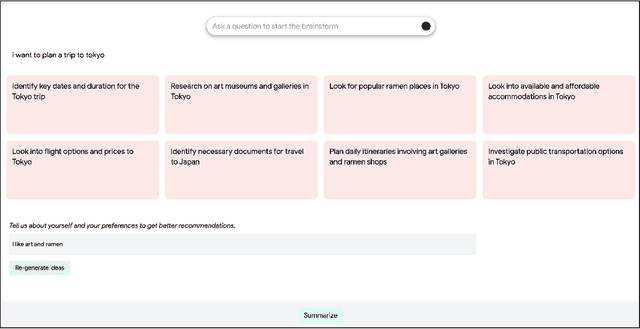
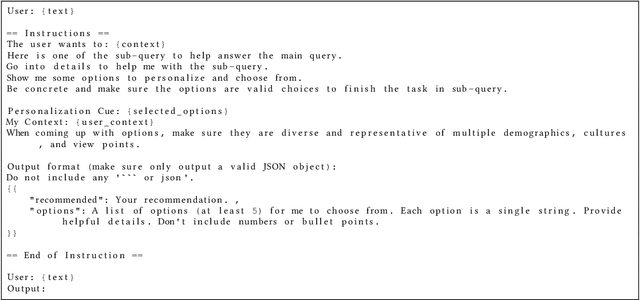

Abstract:Large language model (LLM) powered chatbots are primarily text-based today, and impose a large interactional cognitive load, especially for exploratory or sensemaking tasks such as planning a trip or learning about a new city. Because the interaction is textual, users have little scaffolding in the way of structure, informational "scent", or ability to specify high-level preferences or goals. We introduce ExploreLLM that allows users to structure thoughts, help explore different options, navigate through the choices and recommendations, and to more easily steer models to generate more personalized responses. We conduct a user study and show that users find it helpful to use ExploreLLM for exploratory or planning tasks, because it provides a useful schema-like structure to the task, and guides users in planning. The study also suggests that users can more easily personalize responses with high-level preferences with ExploreLLM. Together, ExploreLLM points to a future where users interact with LLMs beyond the form of chatbots, and instead designed to support complex user tasks with a tighter integration between natural language and graphical user interfaces.
FreshLLMs: Refreshing Large Language Models with Search Engine Augmentation
Oct 05, 2023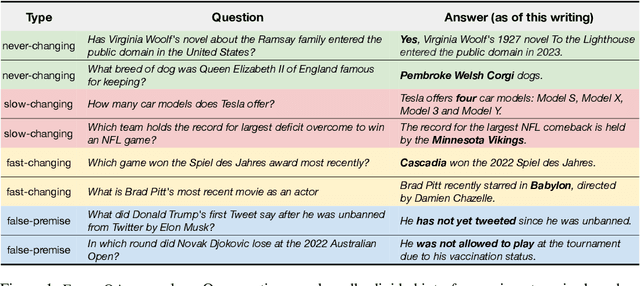



Abstract:Most large language models (LLMs) are trained once and never updated; thus, they lack the ability to dynamically adapt to our ever-changing world. In this work, we perform a detailed study of the factuality of LLM-generated text in the context of answering questions that test current world knowledge. Specifically, we introduce FreshQA, a novel dynamic QA benchmark encompassing a diverse range of question and answer types, including questions that require fast-changing world knowledge as well as questions with false premises that need to be debunked. We benchmark a diverse array of both closed and open-source LLMs under a two-mode evaluation procedure that allows us to measure both correctness and hallucination. Through human evaluations involving more than 50K judgments, we shed light on limitations of these models and demonstrate significant room for improvement: for instance, all models (regardless of model size) struggle on questions that involve fast-changing knowledge and false premises. Motivated by these results, we present FreshPrompt, a simple few-shot prompting method that substantially boosts the performance of an LLM on FreshQA by incorporating relevant and up-to-date information retrieved from a search engine into the prompt. Our experiments show that FreshPrompt outperforms both competing search engine-augmented prompting methods such as Self-Ask (Press et al., 2022) as well as commercial systems such as Perplexity.AI. Further analysis of FreshPrompt reveals that both the number of retrieved evidences and their order play a key role in influencing the correctness of LLM-generated answers. Additionally, instructing the LLM to generate concise and direct answers helps reduce hallucination compared to encouraging more verbose answers. To facilitate future work, we release FreshQA at github.com/freshllms/freshqa and commit to updating it at regular intervals.
Brainformers: Trading Simplicity for Efficiency
May 29, 2023Abstract:Transformers are central to recent successes in natural language processing and computer vision. Transformers have a mostly uniform backbone where layers alternate between feed-forward and self-attention in order to build a deep network. Here we investigate this design choice and find that more complex blocks that have different permutations of layer primitives can be more efficient. Using this insight, we develop a complex block, named Brainformer, that consists of a diverse sets of layers such as sparsely gated feed-forward layers, dense feed-forward layers, attention layers, and various forms of layer normalization and activation functions. Brainformer consistently outperforms the state-of-the-art dense and sparse Transformers, in terms of both quality and efficiency. A Brainformer model with 8 billion activated parameters per token demonstrates 2x faster training convergence and 5x faster step time compared to its GLaM counterpart. In downstream task evaluation, Brainformer also demonstrates a 3% higher SuperGLUE score with fine-tuning compared to GLaM with a similar number of activated parameters. Finally, Brainformer largely outperforms a Primer dense model derived with NAS with similar computation per token on fewshot evaluations.
Rationale-Augmented Ensembles in Language Models
Jul 02, 2022



Abstract:Recent research has shown that rationales, or step-by-step chains of thought, can be used to improve performance in multi-step reasoning tasks. We reconsider rationale-augmented prompting for few-shot in-context learning, where (input -> output) prompts are expanded to (input, rationale -> output) prompts. For rationale-augmented prompting we demonstrate how existing approaches, which rely on manual prompt engineering, are subject to sub-optimal rationales that may harm performance. To mitigate this brittleness, we propose a unified framework of rationale-augmented ensembles, where we identify rationale sampling in the output space as the key component to robustly improve performance. This framework is general and can easily be extended to common natural language processing tasks, even those that do not traditionally leverage intermediate steps, such as question answering, word sense disambiguation, and sentiment analysis. We demonstrate that rationale-augmented ensembles achieve more accurate and interpretable results than existing prompting approaches--including standard prompting without rationales and rationale-based chain-of-thought prompting--while simultaneously improving interpretability of model predictions through the associated rationales.
Least-to-Most Prompting Enables Complex Reasoning in Large Language Models
May 21, 2022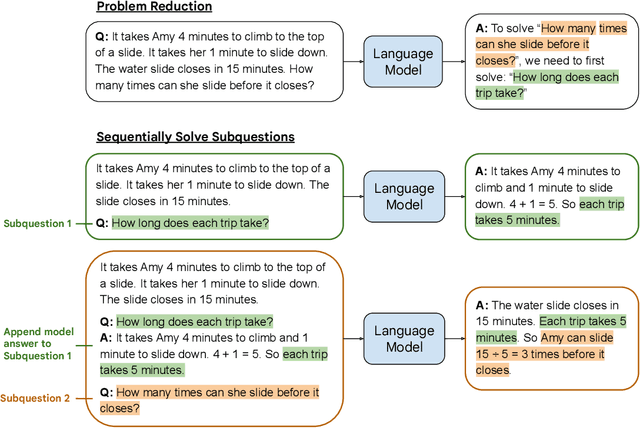
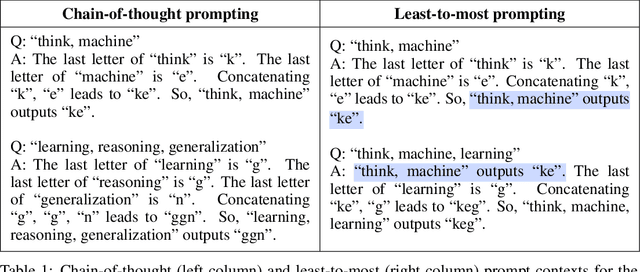
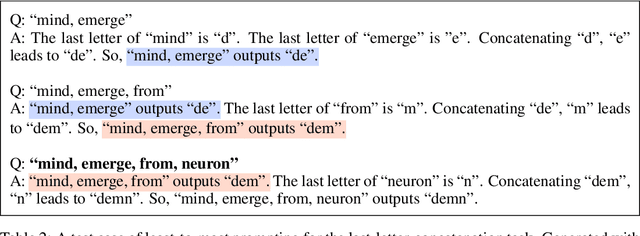

Abstract:We propose a novel prompting strategy, least-to-most prompting, that enables large language models to better perform multi-step reasoning tasks. Least-to-most prompting first reduces a complex problem into a list of subproblems, and then sequentially solves the subproblems, whereby solving a given subproblem is facilitated by the model's answers to previously solved subproblems. Experiments on symbolic manipulation, compositional generalization and numerical reasoning demonstrate that least-to-most prompting can generalize to examples that are harder than those seen in the prompt context, outperforming other prompting-based approaches by a large margin. A notable empirical result is that the GPT-3 code-davinci-002 model with least-to-most-prompting can solve the SCAN benchmark with an accuracy of 99.7% using 14 examples. As a comparison, the neural-symbolic models in the literature specialized for solving SCAN are trained with the full training set of more than 15,000 examples.
Resource-Constrained Neural Architecture Search on Tabular Datasets
Apr 15, 2022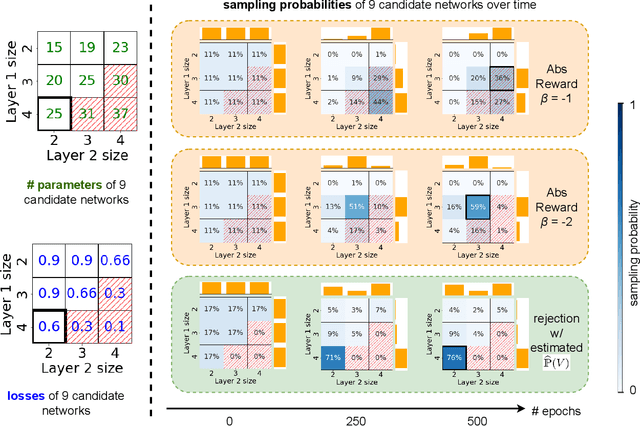

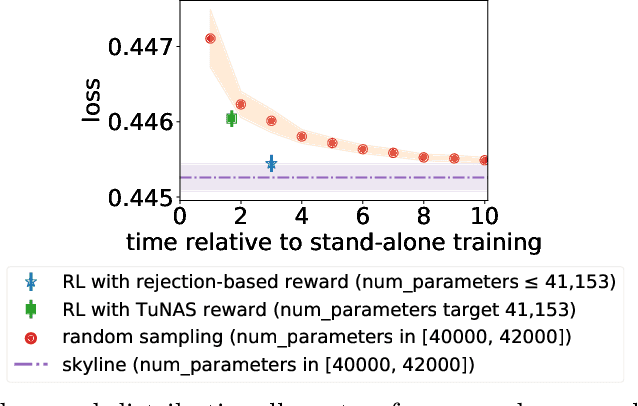

Abstract:The best neural architecture for a given machine learning problem depends on many factors: not only the complexity and structure of the dataset, but also on resource constraints including latency, compute, energy consumption, etc. Neural architecture search (NAS) for tabular datasets is an important but under-explored problem. Previous NAS algorithms designed for image search spaces incorporate resource constraints directly into the reinforcement learning rewards. In this paper, we argue that search spaces for tabular NAS pose considerable challenges for these existing reward-shaping methods, and propose a new reinforcement learning (RL) controller to address these challenges. Motivated by rejection sampling, when we sample candidate architectures during a search, we immediately discard any architecture that violates our resource constraints. We use a Monte-Carlo-based correction to our RL policy gradient update to account for this extra filtering step. Results on several tabular datasets show TabNAS, the proposed approach, efficiently finds high-quality models that satisfy the given resource constraints.
The Carbon Footprint of Machine Learning Training Will Plateau, Then Shrink
Apr 11, 2022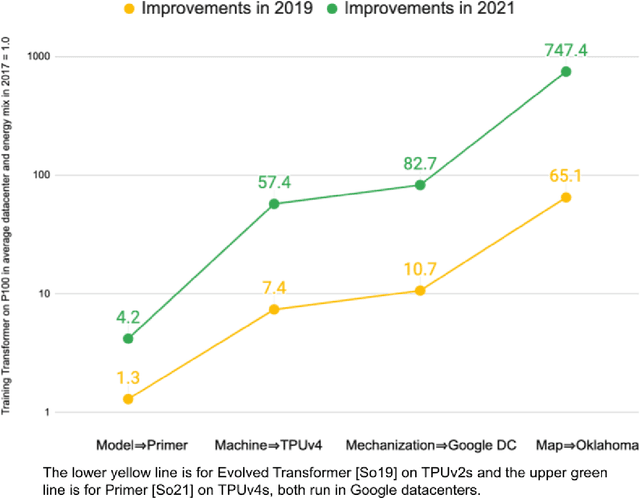
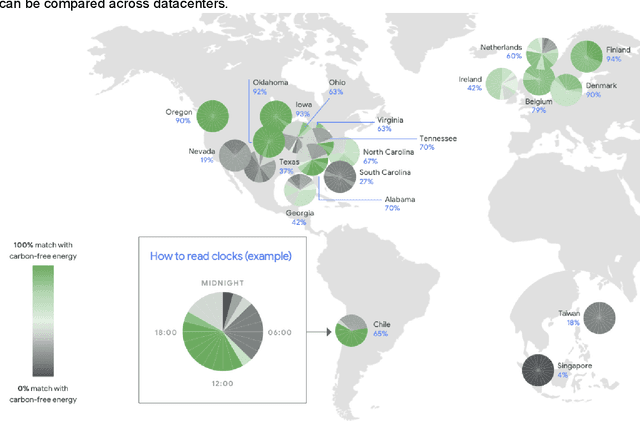
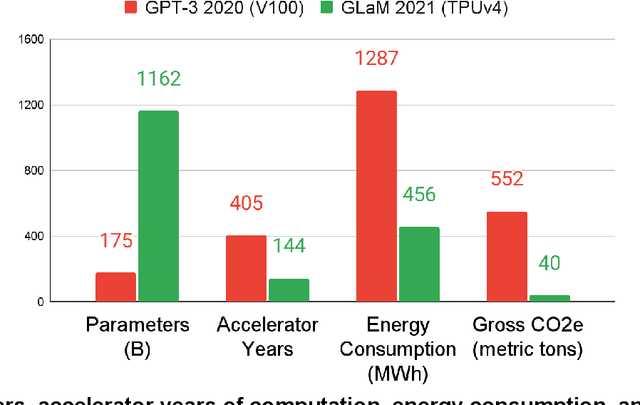
Abstract:Machine Learning (ML) workloads have rapidly grown in importance, but raised concerns about their carbon footprint. Four best practices can reduce ML training energy by up to 100x and CO2 emissions up to 1000x. By following best practices, overall ML energy use (across research, development, and production) held steady at <15% of Google's total energy use for the past three years. If the whole ML field were to adopt best practices, total carbon emissions from training would reduce. Hence, we recommend that ML papers include emissions explicitly to foster competition on more than just model quality. Estimates of emissions in papers that omitted them have been off 100x-100,000x, so publishing emissions has the added benefit of ensuring accurate accounting. Given the importance of climate change, we must get the numbers right to make certain that we work on its biggest challenges.
Self-Consistency Improves Chain of Thought Reasoning in Language Models
Apr 06, 2022



Abstract:We explore a simple ensemble strategy, self-consistency, that significantly improves the reasoning accuracy of large language models. The idea is to sample a diverse set of reasoning paths from a language model via chain of thought prompting then return the most consistent final answer in the set. We evaluate self-consistency on a range of arithmetic and commonsense reasoning benchmarks, and find that it robustly improves accuracy across a variety of language models and model scales without the need for additional training or auxiliary models. When combined with a recent large language model, PaLM-540B, self-consistency increases performance to state-of-the-art levels across several benchmark reasoning tasks, including GSM8K (56.5% -> 74.4%), SVAMP (79.0% -> 86.6%), AQuA (35.8% -> 48.3%), StrategyQA (75.3% -> 81.6%) and ARC-challenge (85.2% -> 88.7%).
 Add to Chrome
Add to Chrome Add to Firefox
Add to Firefox Add to Edge
Add to Edge